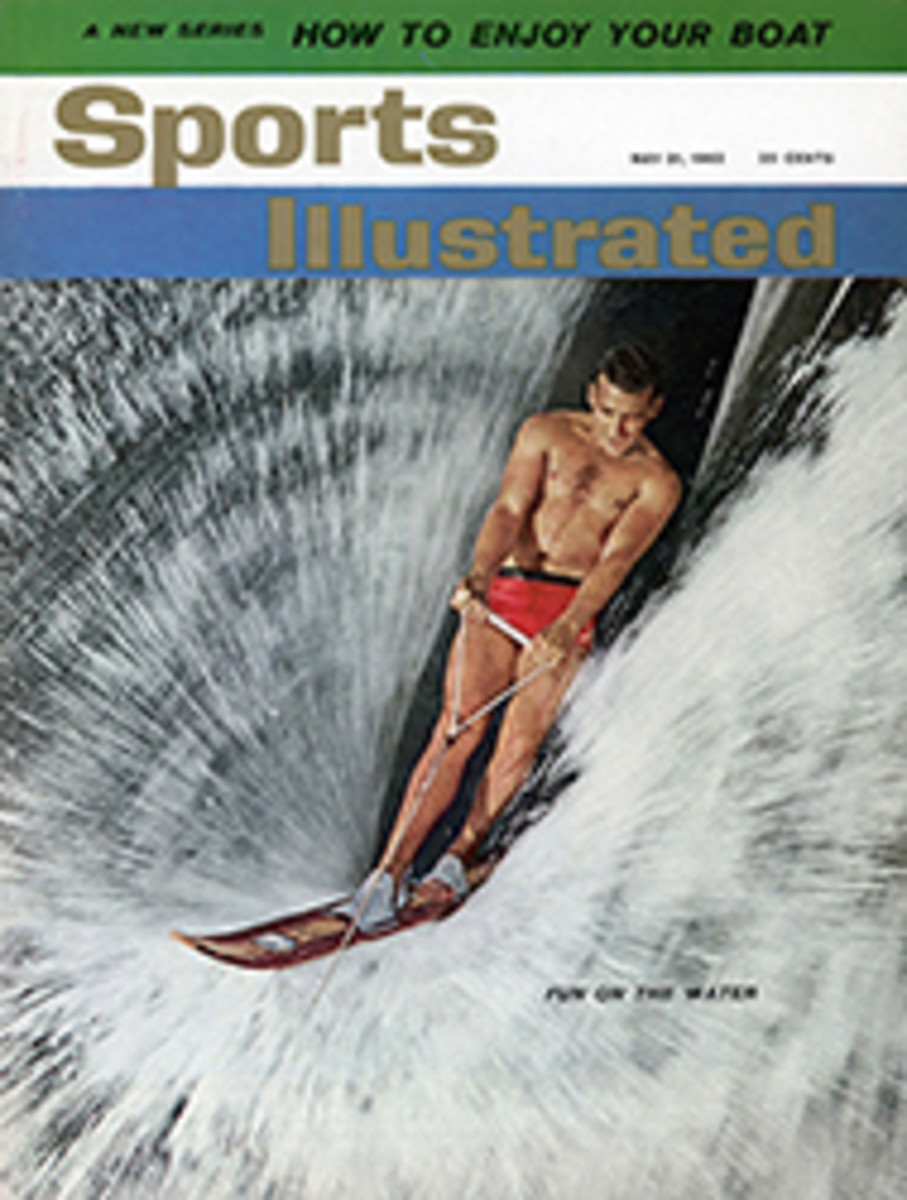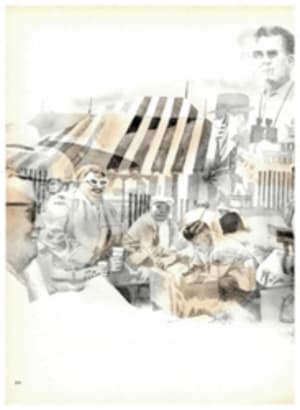
Pray the Sun Shines on Preakness Day
The blight of progress that afflicts all American cities is eating away at Baltimore, pride of what its lamented sage, H. L. Mencken, always referred to as Maryland Free State.
Many of the fine old houses downtown have been razed to make way for skyscraper office buildings and high-rise apartments. Others have been cut up inside to make offices for doctors and hot-plate living quarters. A whole new population has arrived in the city proper. The Easter Parade on fashionable Charles Street is a thing, of the past. The first-class restaurants that survive may be counted on the fingers of one hand.
But there is something in Baltimore that no housewrecker's ball or expressway builder's bulldozer can get at. It is a quality of mind and of spirit, a way of thinking that has long commanded the respect of logicians everywhere in the world.
Baltimore's brand of logic works out this way: Last spring there were some virtuous mutterings against the world-famous (among sailors) striptease joints of East Baltimore Street. David Wallace, then director of the planning council of the Greater Baltimore Committee, promptly issued a statement. He defended the strip-joint area as "an important part of Baltimore, which I would not want to change." He added that, although the strippers' appeal was obviously directed at man's "saucier impulses," they had "a needed liveliness which many cities lack."
The same kind of straight thinking was demonstrated by a Baltimore magistrate who decided cases involving charges of indecent exposure by the strippers with one of the simplest yet most admirable devices to be found in the annals of jurisprudence. This magistrate brought with him to the bench an empty penny matchbox. Then he called for the costume alleged to have been indecent. If he could fit it into the matchbox, he would hold the defendant to be guilty as charged. If the costume could not be squeezed into the little box, he would throw the case out of court without hearing further evidence from either side.
Baltimore does not resist progress solely for the sake of resisting. It tolerates rebuilding as a necessary evil except where the advantages of the new are outweighed by the sentimental attachments for the old. For instance, when the course of an expressway was found to be aiming at a particularly well-loved block of old houses, such a hue and cry went up that the builders had to plan on curving the speedway around the block in question.
But this was nothing compared to the public indignation of a few years ago when there was some talk of demolishing the old Pimlico Race Course and moving the ancient horse race known as the Preakness to Laurel, Md. In letters to the newspapers and in barroom rallies it was made clear to proponents of the Laurel plan that blood would run in the streets if anybody tried to take the Preakness away.
This was as it should be, for the Preakness was first run at Pimlico back in 1873 and is one of Baltimore's dearest treasures. Moreover, given fair weather (so that whole families may picnic in the infield), it is the climax of the most civilized day at the races in America.
Preakness Day resembles nothing so much as a great and amiable family reunion. The crowd is drawn mostly from Baltimore and Maryland, but high public officials come up from Washington and horseplayers of taste and refinement make pilgrimages from distant points.
The Preakness crowd is unique. Although it begins to assemble at 9:30 in the morning and to start eating and drinking at once, there is no wild running about or raucous shouting or fist-fighting or falling down as may be observed, say, at Churchill Downs on Derby Day. The exemplary behavior of Preakness patrons has been attributed to the fact that Maryland rye whisky, given a base of crab meat and fried chicken, is known to have the effect of steadying the gait, sharpening the vision and clearing the mind of all but the most kindly thoughts.
There are all sorts of things to see at Pimlico on Preakness Day before the Preakness itself. The old clubhouse, built in 1870, houses a fine racing library and the National Jockeys Hall of Fame, for which William Hartack has become eligible (and certainly will be nominated) this year. Eddie Arcaro, a six-time Preakness winner, is a charter member of the Hall of Fame along with Earl Sande and George Woolf. If there were a Hall of Fame for trainers, the first to be elected would surely be Sunny Jim Fitzsimmons and Jimmy Jones. Mr. Fitz has saddled four winners, and Jimmy has four to his credit. The two winners saddled by Jimmy's father, the late Ben A., make Calumet the most successful stable in the history of the Preakness.
It is best not to clutter up the mind with too many salient facts about the Preakness, but an unattached male might find a few items useful as conversational fodder should he strike up an acquaintance (as Mencken used to say) with an attractive young widow who has all her first husband's clothes. Man o' War began his great undefeated season in 1920 with a victory in the Preakness, his owner, Samuel Riddle, having decided to skip the Derby. The Preakness is the shortest of the races for the Triple Crown, at a mile and three-sixteenths; the Derby is a mile and a quarter and the Belmont Stakes a mile and a half. The Preakness, with $150,000 added, is the richest of the three races, the richest in the world for which the track has put up the money. Only eight horses have won the Derby and the Preakness and gone on to take the Belmont and the Triple Crown. The last was Citation in 1948.
Everybody should know how the Preakness got its name, but amazingly few people do. The Preakness was named for a horse who was named, in turn, for a village in New Jersey. He had a rather sad life and a tragic end. Big and ungainly looking, he could not help but hear himself referred to as "a cart horse." Even so, he had a respectable record and was very good in the mud. His victory in the first stakes race held at Pimlico in 1870 won him the honor of giving his name to the new stakes for 3-year-olds that was created in 1873. In 1875, when he was 8 years old, Preakness was shipped overseas, purchased by the Duke of Hamilton and put to stud in England. He sired some good-looking offspring (his own sire was the great Lexington) but one day made the mistake of acting up while the Duke was looking him over in his stall. The Duke blew his top, called for a pistol and shot poor Preakness dead.
It is probably unnecessary to remind anybody that the black-eyed Susans draped around the neck of the winner of the Preakness are actually daisies doctored up with shoe polish. However, it might be news to some people that, although this week's running at Pimlico is billed as the 86th, all Preaknesses were not run at Pimlico. From 1894 to 1908, inclusive, the Preakness was in Brooklyn. For four years, between 1890 and 1893, apparently it was not run at all.
Other interesting but nonessential information is to be found in the Pimlico library, but one should not tarry too long there for fear of missing items of entertainment outdoors. These include tootling by the Maryland Jockey Club band, exhibitions by dancing police horses and the running of the Powder Puff Preakness, which is a race for exercise girls and amateur lady riders.
The Powder Puff Preakness posed a delicate problem for Pimlico officials last year. An application was received from Miss Blaze Starr, one of the most admired strippers of East Baltimore Street. Handling the matter with traditional Baltimore tact, the officials drew from Miss Blaze the admission that her riding experience was extremely limited, if not nonexistent. It was then explained to her that she might risk grave damage to her talents in the dash from the starting gate. Miss Blaze was disappointed but was comforted by a counterproposal made by George Cook, a young, straight-thinking Baltimorean who is chairman of the Preakness Ball held in the grand ballroom of the Lord Baltimore Hotel on Preakness Eve under the auspices of the Press Photographers Association.
"Blaze," said Mr. Cook recently, "resolved a difficulty that had been keeping me awake nights in my capacity as chairman of the ball. I was searching for some sort of symbolic effect that would make everyone entering the grand ballroom exclaim, 'This is going to be a grand party!' Hearing that Blaze had been turned down as a rider in the Powder Puff Preakness, I hurried to her chambers at the 2 O'Clock Club. We are old friends. I have known and admired her since she was 19. I explained my problem to Blaze and suggested that if the first sight to greet arriving couples at the ball were Blaze herself they would indeed grasp the idea I had in mind. But obviously Blaze had to be placed in an elevated position of some kind so that she would be clearly visible from all parts of the big room.
"Blaze and I batted a few ideas around there in her dressing room. We thought of having her standing on a judge's stand, wearing a pair of binoculars, but this seemed rather static for a girl accustomed to moving about on a stage. The idea of a trapeze popped into my mind, but Blaze herself ruled this out on the grounds that she is no acrobat in the strict sense of the word.
"Finally, I hit on just the right gimmick—a swing. I called a meeting in the ballroom. Present were representatives of a respected Baltimore engineering firm, a lighting expert, a decorator, practically all the bellboys in the hotel and, naturally, Blaze herself. The swing would be fixed to a beam in the ceiling—the engineers verified the existence of a beam just over the stand where our Dixieland band would be playing—and Blaze would seem to float through the air. She would be, as everybody could see, 'The Spirit of the Preakness,' an effect which Blaze herself said she would emphasize by wearing a G-string festooned with black-eyed Susans."
With Blaze on the swing, the Preakness Ball was a great success, attended by the first citizens of Baltimore who vied with each other in scrambling to catch petals from the black-eyed Susans, which Blaze would, from time to time, toss to the crowd below.
This year's Preakness Ball will again carry out the ideas of Mr. George Cook. The decorations will have a tropical jungle motif, and a calypso band will play during cocktails and dinner. Afterward Sammy Kaye and his orchestra will come on for dancing.
Will Blaze Starr be up on the swing once more? Mr. Cook would not say. "We will have a surprise symbolic effect, perhaps several. It will be a grand party in the best tradition of old Baltimore."
And it will be a grand Preakness Day at old Pimlico—the best day in racing if only the sun will shine on the picnics in the infield.
TWO ILLUSTRATIONS

